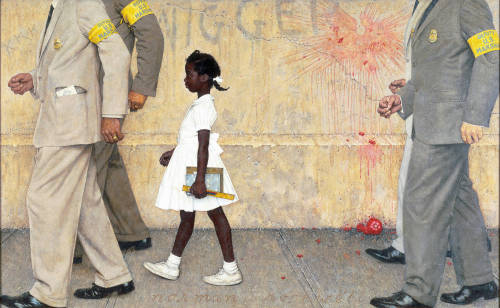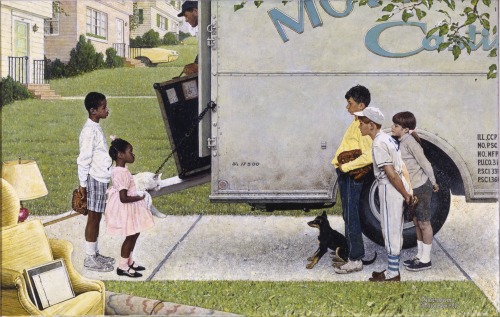#ruby bridges
“The Problem We All Live With”
Norman Rockwell sobre Ruby Bridges
e “New Kids in the Neighborhood” pelo mesmo artista.
Post link





Ruby Nell Bridges Hall is an American civil rights activist. She was the first African-American child to desegregate the all-white William Frantz Elementary School in Louisiana during the New Orleans school desegregation crisis on 14 November 1960.
November 14th…Ruby Nell Bridges Hall

On This Day in Herstory, November 14th 1960, Ruby Nell Bridges Hall an American civil rights activist, became the first Black child to desegregate the all-white William Frantz Elementary School in Louisiana during the New Orleans school desegregation crisis.
Ruby Nell Bridges Hall was born on September 8th 1954 in Tylertown, Mississippi, the eldest of Abon and Lucille Bridges’ five children. She was born at the height of the Civil Rights Movement; only three months before she was born Brown v. Board of Education was decided, declaring the process segregating schools unconstitutional. Despite this ruling many southern states were extremely resistant to integration. Even though it was a federal ruling, many southern state governments were not enforcing the new laws, and this allowed many white schools to remain segregated for years. Eventually, significant pressure from the federal government forced schools to integrate.
When Ruby was four years old, she and her family moved to New Orleans, Louisiana. In 1959 she attended a segregated kindergarten, but at this time the Orleans Parish School Board was forced by the federal government to take steps towards integration. The school board administered an entrance exam to students at Ruby’s school with the intention to keep Black children out of their white schools. Ruby was one of the six Black children in New Orleans to pass the test, which determined they were eligible to attend the all-white William Frantz Elementary School. Initially Ruby’s father was reluctant to send her to the school, but her mother knew that this was a necessary step not just for Ruby’s education, but to “take this step forward…for all African-American children”.
The court order that the first day of integrated schools in New Orleans was on Monday, November 14, 1960. Two of the original six children decided to stay at their old school, and three children were transferred to McDonogh No. 19. So at just six years old, Ruby went to William Frantz Elementary all by herself. On her first day she was escorted by four federal marshals and her mother; the marshals were needed to escort Ruby for her first entire school year. She later described her first day saying, “Driving up I could see the crowd, but living in New Orleans, I actually thought it was Mardi Gras. There was a large crowd of people outside of the school. They were throwing things and shouting, and that sort of goes on in New Orleans at Mardi Gras.” One of her marshals later said, “She showed a lot of courage. She never cried. She didn’t whimper. She just marched along like a little soldier, and we’re all very very proud of her.” The same day that Ruby started at William Frantz Elementary, white parents pulled their children out of the school. All of the school’s teachers, with the exception of one person, refused to teach while a Black child was enrolled. Only Barbara Henry, from Boston, Massachusetts, agreed to teach Ruby, and for a year she taught her alone, “as if she were teaching a whole class.”
Eventually, the protests began to subside and the white children returned to school, despite this, Ruby remained the only child in her class, for an entire school year. Even though the protests wound down, for the entirety of her first year at William Frantz Elementary, every morning as she walked in one woman threatened to poison Ruby, while another woman held up a Black doll in a coffin. As a result, the marshals only allowed Ruby to eat the food she had brought from home. Unfortunately, Ruby’s entire family initially suffered for their role in the school’s integration; her father lost his job as a gas station attendant; the grocery store where they shopped no longer let them shop there; her grandparents, who were sharecroppers in Mississippi, were turned off their land; and her parents separated. However, many other people in their community showed support for the Bridges in other ways. Some white families continued to send their children to Frantz despite the protests, a neighbor provided her father with a new job, and local people babysat for Ruby’s siblings, watched the house as protectors, and walked behind the federal marshals’ car on the trips to school. Much later in life Ruby learned that even the immaculate clothing she wore to school in those first weeks were sent to her family by an acquaintance of the family.
Today, Ruby still lives in New Orleans with her husband, Malcolm Hall, and their four sons. After she graduated from a desegregated high school, she worked as a travel agent for 15 years and eventually became a stay-at-home parent. Now she is the chair of the Ruby Bridges Foundation, which she formed in 1999 to promote “the values of tolerance, respect, and appreciation of all differences”. She says the mission of the group is, “racism is a grown-up disease and we must stop using our children to spread it.”
Ruby is the subject of a 1964 painting, The Problem We All Live With by Norman Rockwell. Her book, Through My Eyes won the Carter G. Woodson Book Award in 2000. On January 8, 2001, she was awarded the Presidential Citizens Medal by President Bill Clinton. Unfortunately, like many other, Ruby lost her home during Hurricane Katrina in 2005. Katrina also greatly damaged William Frantz Elementary School, and Ruby was instrumental in fighting for the school to remain open. On July 15th 2011, she met with President Barack Obama at the White House. Together they viewed the Norman Rockwell painting of her on display, and he told her, “I think it’s fair to say that if it hadn’t been for you guys, I might not be here and we wouldn’t be looking at this together”. In 2014, a statue of Ruby was unveiled in the courtyard of William Frantz Elementary School.
“Each and every one of us is born with a clean heart. Our babies know nothing about hate or racism. But soon they begin to learn - and only from us. We keep racism alive. We pass it on to our children. We owe it to our children to help them keep their clean start.”
RUBY BRIDGES

LAST WEEK OF BLACK HISTORY MONTH
Day 4 of 7 Black activists to celebrate
RUBY BRIDGES:
Ruby Bridges, born September 8, 1954, became one of the first black children to intergrate New Orleans all-white public school system.
She was only 6 years old when she was first escorted to her class with her mother and U.S. marshals due to violent mobs.
During this time was the Civil Rights Movement, so Bridges brave act was a true milestone for African Americans.
Her time in this school was not easy for her or her family. *Please read all about it truly sad what they said to a 6 year trying to get an education.*
Through the years she had books written about her and in 1999 she released her own memoir, Through My Eyes, and that same year she established the Ruby Bridges Foundation.
To this day Ruby Bridges continues speaking on injustices and inequailty for Black people.
Her legacy lives on.
THANK YOU RUBY BRIDGES



